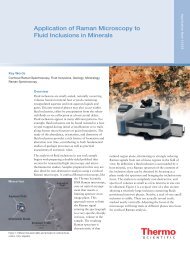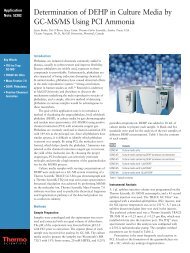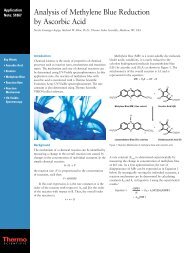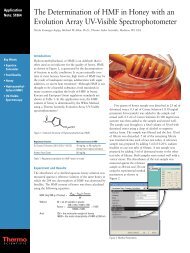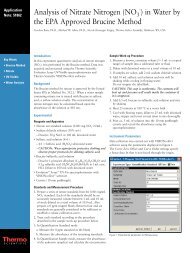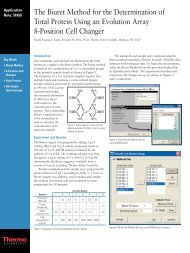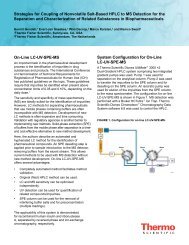Gentamicin Sulfate Assay by HPLC with Charged Aerosol ... - Dionex
Gentamicin Sulfate Assay by HPLC with Charged Aerosol ... - Dionex
Gentamicin Sulfate Assay by HPLC with Charged Aerosol ... - Dionex
- No tags were found...
You also want an ePaper? Increase the reach of your titles
YUMPU automatically turns print PDFs into web optimized ePapers that Google loves.
2 Aminoglycoside antibiotic assays, including those forgentamicin sulfate, are frequently microbial assays. 5 Theseassays measure activity; however, they cannot quantifyimpurities or determine content of specific compounds ina product. For this reason, chromatographic techniquesare often favored for improved specificity and the abilityto differentiate impurities that have the potential for bothantibiotic activity and unintended side effects. Sisomicin, acommon impurity in gentamicin sulfate, is also a prescribedantibiotic <strong>with</strong> similar activity but greater renal toxicity. 1The potential for such adverse events requires thatimpurities be determined. Aminoglycoside determinationpresents several challenges because the structuralsimilarities in the compounds make separation of theindividual components <strong>with</strong>in gentamicin sulfatepotentially difficult. The gentamicin C congeners differ <strong>by</strong>methylation at three potential sites, as shown in Figure 1.However, these otherwise hydrophilic compounds can beseparated <strong>by</strong> reversed-phase high-performance liquidchromatography (<strong>HPLC</strong>) <strong>with</strong> strong ion-pairing reagentsthat assist in accentuating the small hydrophobicitydifferences.In addition to separation challenges, aminoglycosideantibiotics do not contain chromophores, making UVdetection insensitive. To compensate for this lack of achromophore, derivatization techniques have beendeveloped. The U.S. Pharmacopeia (USP) gentamicinsulfate monograph specifies content determination aftergentamicin derivatization <strong>with</strong> o-phthalaldehyde. 6 Aftersample derivatization, the gentamicins are separated on aC18 reversed-phase column (USP L1) and quantified <strong>by</strong>UV detection. This method, although effective, is anindirect detection method, which requires additionalpreparation time and reagents for derivatization.Other detection techniques are available for compoundsthat lack UV chromophores. This work investigatesgentamicin sulfate sample analysis <strong>by</strong> reversed-phase<strong>HPLC</strong> <strong>with</strong> charged aerosol detection. This detectiontechnique does not rely on the presence of a chromophoreand does not require derivatization of samples fordetection. <strong>Charged</strong> aerosol detection is based onnebulization of the column eluent and formation ofanalyte particles. These particles become charged <strong>by</strong>reacting <strong>with</strong> a stream of nitrogen gas that was previouslycharged after passing over a corona discharge needle.The charged particles then pass through an electrometer andthe current is measured. This technique is ideal for nonvolatileanalytes that do not have a chromophore and is compatible<strong>with</strong> many volatile ion-pairing reagents, which are needed tosuccessfully separate the gentamicin congeners.GoalDevelop a rugged <strong>HPLC</strong> <strong>with</strong> charged aerosoldetection method to separate and detect the gentamicincongeners in gentamicin sulfate drug substance andgentamicin sulfate-containing ointments, solutions,and creamsEquipment• Thermo Scientific <strong>Dionex</strong> UltiMate 3000 RapidSeparation LC (RSLC) system including:– SRD-3600 Integrated Solvent and Degasser Rack,6 Channels (P/N 5035.9230)– HPG-3400RS Binary Rapid Separation Pump <strong>with</strong>Solvent Selector Valves (P/N 5040.0046)– WPS-3000TRS Rapid Separation Wellplate Sampler,Thermostatted (P/N 5840.0020)– TCC-3000RS Rapid Separation ThermostattedColumn Compartment (P/N 5730.0000)• Thermo Scientific <strong>Dionex</strong> Corona ultra RS <strong>Charged</strong><strong>Aerosol</strong> Detector (P/N 70-9406)Also used for identification of analytes:– WPS-3000TBFC Thermostatted BiocompatiblePulled-Loop Well Plate Autosampler <strong>with</strong> IntegratedFraction Collection (P/N 5825.0020)• Thermo Scientific Q Exactive Benchtop LC-MS/MSmass spectrometer (P/N IQLAAEGAAPFALGMAZR)• Vial Kit, 0.3 mL Polypropylene <strong>with</strong> Caps and Septa,100 Each (P/N 055428)• Filter Unit, 0.2 µm nylon membrane, 1 L capacity(P/N 164-0020)• Thermo Scientific <strong>Dionex</strong> ChromeleonChromatography Data System (CDS) software:– Version 7.1 was used for sample analysis datacollection and processing– Version 6.8 was used for fraction collection• Thermo Scientific Xcalibur 2.2 SP1 <strong>with</strong> Foundation 2.0SP1 and Q Exactive Orbitrap MS instrument controlsoftware 2.0 SP1Reagents and Standards• Deionized (DI) water, Type I reagent grade, 18 MΩ-cmresistivity or better• Acetonitrile (P/N A955-4)• Heptafluorobutyric acid (HFBA) (AcrosP/N 172800250)• Trifluoroacetic acid (TFA), LC/MS grade (P/N A116-50)• <strong>Gentamicin</strong> sulfate, USP grade (Sigma-Aldrich ®P/N G1914)Sample• <strong>Gentamicin</strong> sulfate samples were provided as agenerous gift.
ConditionsColumn:Thermo Scientific Acclaim RSLC PA2,2.2 µm Analytical (2.1 × 100 mm)Mobile Phase A: 0.025:5:95 HFBA:acetonitrile: DI waterMobile Phase B: 0.3:5:95 TFA:acetonitrile: DI waterGradient: From 0 to 3 min: 1–10% mobile phase B(99–90% mobile phase A)From 3 to 8 min: 10–100% mobile phase B(90–0% mobile phase A)From 8 to 11 min: 100 % mobile phase B4 min of equilibration at 99% mobile phase Abefore injectionFlow Rate: 0.45 mL/minInj. Volume: 1.0 μLTemperature: 15 °CDetection: <strong>Charged</strong> aerosol detector, low filter, 60 Hz datacollection rate, nebulizer temperature, 15 °CSystemBackpressure: ~450 barNoise: ~0.07 pA (charged aerosol detection)Run Time: 11 min (4 min equilibration)Preparation of Solutions and ReagentsMobile Phase PreparationMobile phase A: Add 950 mL (950 g) of DI water to a 1 Lglass bottle. Add 50 mL of acetonitrile to the DI waterand mix the solution. Add 250 µL of HFBA to theacetonitrile solution and mix well.Mobile phase B: Add 950 mL (950 g) of DI water to a 1 Lglass bottle. Add 50 mL of acetonitrile to the DI waterand mix the solution. Add 3.0 mL of TFA to theacetonitrile solution and mix well.Alternate mobile phase preparation method: If baselinedistortion is observed, prepare the mobile phases asfollows: Add 100 mL acetonitrile to 1900 mL DI water toprepare 2 L of 5:95 acetonitrile:water. Add 250 µL HFBAto 1 L of this solution to prepare mobile phase A. Add3.0 mL TFA to the remaining 1 L of this solution toprepare mobile phase B. Prepare the mobile phases in thisway to minimize the differences in the amount ofacetonitrile in each mobile phase, which leads to reducedchanges in response due to organic mobile phase contentat the charged aerosol detector. The preparation of the5:95 acetonitrile:water solution may be scaled as needed.Standards and Sample SolutionsStandards: Weigh 16.73 mg of gentamicin sulfate into apreweighed glass vial. Dry the gentamicin sulfate in theglass vial for 1 h at 113 °C. Remove the vial and allow itto cool in a desiccator. Once the vial and gentamicinsulfate are cool, reweigh the vial to determine the mass ofthe dried gentamicin sulfate, which in this case is 14.68 mg.Add 2.94 mL of DI water to prepare a 5.0 mg/mL stocksolution of gentamicin sulfate. Systematically elevatedvalues for gentamicin content of samples will be observedif the standard is not dried before use. The amount of thiserror will depend on the amount of water the gentamicinsulfate standard has absorbed.Aqueous saline-based samples: Dilute samples <strong>by</strong> a factorof 50 in DI water prior to analysis. Add 20.6 mg of sampleto a 1.5 mL vial. Add 1.25 mL of DI water to the sample.Mineral oil-based samples (ointments and creams): Add102.67 mg of sample into a 1.5 mL microcentrifuge tube.To this sample add 100 µL of ethyl acetate to disperse theoils. Vortex repeatedly until a suspension of sample isformed in the ethyl acetate. Add 500 µL of DI water tothe suspension and vortex again until the sample is wellsuspended in the water. Centrifuge at 16,000 × g rpm for10 min to separate the DI water, ethyl acetate, and mineraloil from each other. Collect sample aliquots from thebottom aqueous layer in the microcentrifuge tube using aconical gel-loading pipette tip. Dilute the extracts fromointments 1:1 <strong>with</strong> DI water. Dilute ophthalmic ointmentsamples 1:3 <strong>with</strong> DI water. For cream samples, increasecentrifugation time to 30 min. The phase separation willnot be as stable as <strong>with</strong> ointment samples. After collectionof the aliquots from the aqueous extract, dilute thesesamples 1:3 <strong>with</strong> DI water before injection.Data Processing: Group IntegrationIntegration of the gentamicin peaks is accomplished <strong>by</strong>group integration <strong>with</strong>in the Chromeleon CDS software.To do this, create a group, such as gentamicin, in theprocessing method component table. Assign any peak thatis part of the gentamicin complex to this group. In thiswork, the first major peak in the gentamicin complex,gentamicin C 1a, is selected as the peak to contain theconcentration values of all standards. The remainingindividual components—C 2, C 2b, C 2a, and C 1—are givennull concentration values. For calibration and sampleanalysis, the group amount is reported for any peak in thegroup. To add the group amount column to a table, rightclick on the table, chose Insert Column, and choose theGroup Amount variable from the Peak Results categories.If desired, calculate amount values of individual componentsof the group based on the relative peak area of theindividual component compared to the total peak area ofthe group. For this work, the amounts of the individualgentamicin congeners are not used for calculations.PrecautionsAfter initial installation, allow the column to condition at50% mobile phase A and 50% mobile phase B for aminimum of 4 h prior to injecting samples and connectingto the charged aerosol detector to achieve minimumbackground and stable retention times.To minimize carryover at the autosampler, ensure that aDI water needle wash occurs both before and after aninjection. Exercise care when collecting the samples toavoid introducing organic material into the aqueoussamples. Due to the mineral oil matrix, a column wash of80% acetonitrile may be necessary after several samplesare injected if any organic phase from the extraction hasbeen introduced into the injected sample.3
4 Retention time reduction will be observed as the columnages and samples are injected. To extend column lifetime,a 20 min column wash of 80% acetonitrile in water isrecommended at the end of each sequence to remove anyresidual sample components and TFA-based mobile phasefrom the column.Results and DiscussionSeparationMultiple reversed-phase columns were investigatedfor the separation of gentamicin sulfate, includingpentafluorophenyl and embedded polar phases. In eachcase, TFA was necessary for high-resolution separations.Substitution of all or part of the TFA <strong>with</strong> formic acidor trichloroacetic acid was not effective in resolving theindividual compounds in the gentamicin complex.Prior publications have shown separation of thegentamicin congeners <strong>by</strong> many methods, <strong>with</strong> run timesranging from 20 to 80 min. 2-4, 7 A particularly effectivemethod for retaining decomposition products wasreported on pentafluorophenyl stationary phases usinghigh concentrations of TFA (between 1 and 2%) for theseparation. 7 Although the resolution of these separationsis excellent, this concentration of TFA is damaging to thecolumn, which can lead to detector contamination andis not recommended for long-term ruggedness. For thisreason, separations that employ lower concentrations ofTFA were investigated.The lowest TFA concentration that resulted in consistentresolution of gentamicin components was 0.3% whenusing the Acclaim RSLC PolarAdvantage II (PA2)column. This column allowed good separation of theprimary components of gentamicin as well as sisomicin,which elutes just before gentamicin C 1a. As <strong>with</strong>previously published methods, a low concentrationof HFBA was included in the gradient to improveretention of small degradation products of gentamicin,such as garamine.Figure 3 shows the separation of USP-grade gentamicinsulfate on the Acclaim RSLC PA2 column <strong>with</strong> a HFBA/TFA gradient. The column temperature was maintainedat 15 °C, which allowed greater separation betweengentamicin C 2band gentamicin C 2. Elution conditions attemperatures ranging from 15 to 35 °C were investigatedwhile maintaining an analysis time of
Quantification <strong>Assay</strong> Linearity and PrecisionLinearity of response for the gentamicin complex wasinvestigated between 0.025 and 0.75 mg/mL of gentamicinsulfate (0.017–0.51 mg/mL as free gentamicin base). Thequantification of samples was corrected <strong>by</strong> the certificateof analysis value of gentamicin base. Calibration data werefit <strong>with</strong> a quadratic model. The coefficient of determination(based on linear conversion of the data) was 0.997.Precision of the method was evaluated <strong>by</strong> measuringretention time and peak area RSDs for seven replicateinjections of a 0.10 mg/mL gentamicin sulfate standard.Table 1 summarizes these precisions.Retention time precision (as RSD) was excellent, rangingfrom 0.04 to 0.24. Peak area precision for individualgentamicin congeners was typically
6Table 2. Results for one day of replicate sample analysisSampleMeasured<strong>Gentamicin</strong>Concentration(mg/mL)Precision(RSD) n = 3Label Claim(% <strong>Gentamicin</strong> Base)DeterminedSample Amount(% <strong>Gentamicin</strong> Base)AmountSpiked(mg/mL)Ointment (rep. 1) 0.12 0.81 0.1 0.1 0.080 103Ointment (rep. 2) 0.14 4.86 0.1 0.1 0.080 111Ointment (rep. 3) 0.13 2.63 0.1 0.1 0.080 113Recovery(%)Ophthalmic Ointment(rep. 1)0.13 2.12 0.3 0.3 0.080 111Ophthalmic Ointment(rep. 2)0.13 0.77 0.3 0.3 0.080 92Ophthalmic Ointment(rep. 3)0.13 1.09 0.3 0.3 0.080 80Cream (rep. 1) 0.087 1.87 0.1 0.1 0.010 101Cream (rep. 2) 0.087 1.12 0.1 0.1 0.010 98Cream (rep. 3) 0.073 1.79 0.1 0.1 0.010 98Ophthalmic Solution(rep.1)0.051 1.64 0.3 0.3 0.034 112Ophthalmic Solution(rep.2)0.052 3.02 0.3 0.3 0.034 91Ophthalmic Solution(rep.3)0.055 1.27 0.3 0.3 0.034 93
Table 3. Results for three days of triplicate analysis: analysis precision (as RSD) is provided for both the determined concentration of gentamicin base in the extractsand for the overall assay after calculating the amounts in the product, then correcting for the dilutions and the mass of product analyzed.7Sample (Day)Ophthalmic Solution(Day 1)Ophthalmic Solution(Day 2)Ophthalmic Solution(Day 3)Ophthalmic Ointment(Day 1)Ophthalmic Ointment(Day 2)Ophthalmic Ointment(Day 3)Cream(Day 1)*Cream(Day 2)Cream(Day 3)Determined<strong>Gentamicin</strong> Amount(mg/mL)IntradayPrecision (RSD)Determined<strong>Gentamicin</strong> Basein Sample (mg/g)Between-DayPrecision(DeterminedAmount as RSD)Between-DayPrecision(<strong>Assay</strong> as RSD)0.069 1.9 3.4 11.8 6.70.067 3.30.069 3.40.058 5.4 2.80.064 3.20.064 3.10.051 4.2 2.90.052 3.10.055 3.10.14 12.3 3.1 10.9 6.50.17 3.30.15 3.30.16 0.4 3.00.16 3.20.16 3.20.13 0.9 2.80.13 2.80.13 2.80.071 2.6 1.1 11.5 9.90.073 1.10.075 1.20.073 8.3 1.20.063 1.30.063 1.30.087 9.8 1.00.087 1.00.073 1.1*Determined gentamicin base concentrations for cream sample extracts have been corrected for dilution.
ConclusionIn this work, a direct-detection reversed-phase <strong>HPLC</strong>chromatographic assay was developed for gentamicinsulfate. This method uses an Acclaim RSLC PA2 column,which allows the reduction of the concentration of TFAcompared to published methods, making the methodmore suitable for long-term use for both the column andthe detector. By using charged aerosol detection,derivatization is not necessary. Three sample matrixescontaining gentamicin sulfate were analyzed to determinethe content of gentamicin. The quantification ofgentamicin base had good recoveries and was consistent<strong>with</strong> the label claim of these products, both indicators ofan accurate assay. This method is faster than previouslypublished methods, <strong>with</strong> excellent separation between thegentamicin congeners and resolution of many impuritiesthat can be present in fermentation-manufacturedproducts.SupplierSigma-Aldrich, P.O. Box 14508, St. Louis, MO 63178,U.S.A., Tel: 800-325-3010. www.sigma-aldrich.comReferences1. Siegenthaler, W.E.; Bonetti, A.; Luthy, R.Aminoglycoside Antibiotics in Infectious Diseases.Amer. J. of Med. 1986, 80, 2–14.2. Li, B.; Adams, E.; Van Schepdael, A.; Hoogmartens, J.Analysis of Unknown Compounds in <strong>Gentamicin</strong>Bulk Samples <strong>with</strong> Liquid Chromatography Coupled<strong>with</strong> Ion Trap Mass Spectrometry. Rapid Commun.Mass Spectrom. 2006, 20, 393–402.3. Li, B.; Van Schepdael, A.; Hoogmartens, J.; Adams, E.Mass Spectrometric Characterization of <strong>Gentamicin</strong>Components Separated <strong>by</strong> the New EuropeanPharmacopoeia Method. J. Pharm. Biomed. Anal.2011, 55, 78–84.4. Park, J.W.; Hong, J.S.J.; Parajuli, N.; Koh, H.S.; Park,S.R.; Lee M.O.; Kim, S.K.; Yoon, Y.J. AnalyticalProfiling of Biosynthetic Intermediates Involved in the<strong>Gentamicin</strong> Pathway of Micromonospora echinospora<strong>by</strong> High-Performance Liquid Chromatography UsingElectrospray Ionization Mass Spectrometric Detection.Anal. Chem. 2007, 79, 4860–4869.5. Biological Tests and <strong>Assay</strong>s, Antibiotics–Microbial <strong>Assay</strong>s, The U.S. Pharmacopeia 34,National Formulary 29, Washington, DC, 2011, p 70.6. <strong>Gentamicin</strong> <strong>Sulfate</strong>, The U.S. Pharmacopeia 34,National Formulary 29, Washington, DC, 2011,p 2959.7. Joseph, A.; Rustrum, A. Development and Validationof a RP-<strong>HPLC</strong> Method for the Determination of<strong>Gentamicin</strong> <strong>Sulfate</strong> and its Related Substances in aPharmaceutical Cream using a ShortPentafluorophenyl Column and a <strong>Charged</strong> <strong>Aerosol</strong>Detector. J. Pharm. Biomed. Anal. 2010, 51, 521–531.8. <strong>Gentamicin</strong> <strong>Sulfate</strong> Cream, The U.S. Pharmacopeia34, National Formulary 29, Washington, DC, 2011,p 2960.9. <strong>Gentamicin</strong> <strong>Sulfate</strong> Ophthalmic Ointment, The U.S.Pharmacopeia 34, National Formulary 29,Washington, DC, 2011, p 2961.10. <strong>Gentamicin</strong> <strong>Sulfate</strong> Ophthalmic Solution, The U.S.Pharmacopeia 34, National Formulary 29,Washington, DC, 2011, p 2962.Application Note 1005www.thermoscientific.com©2012 Thermo Fisher Scientific Inc. All rights reserved. ISO is a trademark of the International Standards Organization.Signa-Aldrich is a registered trademark of Signa-Aldrich Co. LLC. All other trademarks are the property of Thermo FisherScientific Inc. and its subsidiaries. Specifications, terms and pricing are subject to change. Not all products are available in allcountries. Please consult your local sales representative for details. This information is presented as an example of thecapabilities of Thermo Fisher products. It is not intended to encourage use of these products in any manners that might infringethe intellectual property rights of others.Thermo Fisher Scientific(Bremen) GmbH.Management SystemRegistered to ISO 9001:2008Thermo Scientific <strong>Dionex</strong>products are, designed,developed, and manufacturedunder an ISO 9001 Quality System.U.S./Canada (847) 295 7500Australia (61) 2 9420 5233Austria (43) 1 616 51 25Benelux (31) 20 683 9768(32) 3 353 42 94 Brazil (55) 11 3731 5140China (852) 2428 3282Denmark (45) 36 36 90 90 France (33) 1 39 30 01 10 Germany (49) 6126 991 0India (91) 22 2764 2735 Ireland (353) 1 644 0064Italy (39) 02 51 62 1267Japan (81) 6 6885 1213Korea (82) 2 3420 8600Singapore (65) 6289 1190Sweden (46) 8 473 3380Switzerland (41) 62 205 9966 Taiwan (886) 2 8751 6655United Kingdom (44) 1276 691722AN70016_E 05/12S



